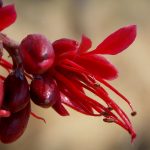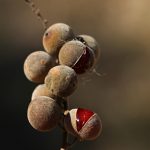TREE LIFE
FEBRUARY 1990
MASHONALAND CALENDAR
Tuesday 6th February : Botanic Garden Walk. Park your car at the Herbarium where we will meet at 1645 hours for 1700 hours.
Sunday 18th February : Nyarupinda in the Raffingora area and home of Maurice and Dicky Graves is the venue for this outing, and what better introduction than Benedicta’s enticing articles which have appeared in Tree Life over the past few months. This is going to be a super outing and we hope to fill the bus which will leave the Monomatapa car park at 0830 hours sharp. A security guard will look after cars left in the car park. The bus fare is $25. Please phone Joy Killian on 308398 before Thursday 15th to reserve your seat on the bus.
Saturday 4th February : Walk with Mark Hyde. Please phone him at home on 701023 before Friday 23rd for time and venue.
MATABELELAND CALENDAR
On Sunday 4th February we are going to Richmond Park, (just beyond Falls Road Motors), on the Victoria Falls Road, to see the varied countryside in 1500 acres and also to hold our Annual General Meeting. Meet at Falls Road Motors at 0830 hours, morning only.
On Sunday 18th February an extra for those interested. The Girl Guides want us to name some of their trees around the buildings in Rowallan Park (just before the Moth Shrine), Matopos. We will make this an all day outing with the proviso that it is a working outing in an attractive area, to identify and label trees. Bring lunch and meet at Retreat at 0830 hours.
Saturday 3rd March (Ken and Betty are off on holiday the next day). Meet at Grafotype, 81 Mafeking Road at 0830 hours where cars may be left under lock and key. We then proceed to Derek and Barbara Viljoen’s Farm, Beaconsfield. A very interesting area including the site of the Shashane Dam. Bring lunch and chairs. There is a shady lawned area by the homestead, overlooking a large dam.
MATABELELAND NOTES
On Sunday 7th January we went to Balla Balla Ranch where we identified some 75 species. Of interest were : Acacias – A. arenaria, A. ataxacantha, A. fleckii, A. karroo, A. rehmanniana, Albizia amara, A. tanganyicensis, the brown paper bark, Artabotrys brachypetalus, very many mountain Acacia, Brachystegia glaucescens, B. spiciformis, msasa, not common in these parts, Cassia abbreviata, with fine long pods, Catha edulis, Cantunaregam spinosa, (Xeromphis obovata), and what we thought were Coddia rudis (Xeromphis rudia); these last two are new to most of us, and caused some headaches; Combretum apiculatum, C. hereroense, C. imberbe, leadwood, widespread, C. molle, Commiphora pyracanthoides, Clerodendrum myricoides, Crossopteryx febrifuga, widespread, Dalbergia melanoxylon, Erythrina latissima, Faurea saligna, Ficus ingens, F. glumosa, F. natalensis, Flacourtia indica with very large fruits,
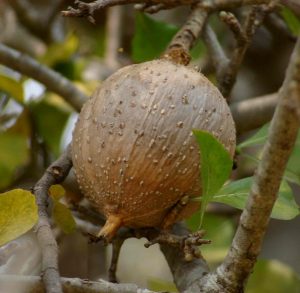
Gardenia volkensii. Photo: Bart Wursten. Source : Flora of Zimbabwe
Gardenia volkensii, G. ternifolia a new species for us here, Hexalobus monopetalus, Julbernardia globiflora, Lonchocarpus capassa, Margaritaria discoidea (Phyallanthus), Markhamia zanzibarica (M. acuminata), Mundulea sericea, Ozorea insignis, subsp. reticulata, Pappea capensis, Pavetta schumanniana, Piliostigma thonningii, Pterolobium stellatum, Rhus lancea, R. leptodictya, Sclerocarya birrea, Strychnos madagascariensis, Tarenna neurophylla, Terminalia sericea, T. trichopoda, Turraea nilotica. In the afternoon we went on to Alice Farm, Esigodini, overlooking Ncema Dam. There we added further Acacias : A. galpinii, A. gerrardii and A. nigrescens, also Erythroxylum emarginatum and Peltophorum africanum.
C.Sykes. Hon. Secretary
TREE MAPPING
In Tree Life No. 109 details of the Tree Mapping exercise were given. Copies are available for interested members on application to our Secretary, Maureen Silva Jones. Your Committee intends to get this project going as soon as possible. Volunteers are required for the following vital aspects of the exercise.
- a) Clerical duties – collating known information and new information as it comes in. Contact Kim Damstra (home Harare 35758) who is coordinating this activity. Knowledge of trees not essential – your time is what we want.
- b) Recording duties – completing cards in the field, and forwarding them and unidentified samples for identification. Cards will be sent to volunteers on application to the secretary
Note
1 Potential volunteers should not be put off by the subspecies and varieties listed in Tree Life No. 109. Just do the best that you can.
2 Samples for identification should be pressed between sheets of newspaper and forwarded to the Secretary ASAP either to P.O. Box 2128 Harare or personal delivery to Maureen Silva Jones at OXYCO, Southampton House, Union Avenue, 1st Street, Harare.
3 If you cannot identify the Quarter Degree Square in which you are recording, give as much detail as possible, e.g. farm name, distance and bearing from nearest town or service centre. All ZRP Charge Offices have 1/50 000 map coverage of their areas and help can be obtained from that source.
BOTANIC GARDEN WALK : JANUARY 1990 : Acacias continued
We began the walk by discussing the exotic Australian chestnut or Moreton Bay chestnut (Castanospermum australa). This is one of those trees that I had not noticed before last month and now find that they are very common indeed. I obviously walk around with my eyes closed sometimes. It is a legume with swollen pods and large seeds which are poisonous when raw but the black beans roasted are edible. Apparently it has been suggested that compounds from this tree may help to suppress the AIDS virus, but this has not been confirmed. The first specimen was brought to Southern Rhodesia by Andre Holland’s grandfather and grows on the corner of North and chancellor Avenues on the Prime Minister’s property. It used to have a plaque on it.
Back to Acacias. We went back to looking at the scattered thorned acacias. A. ataxacantha and A. schweinfurthii still cause confusion in our lives. The shape of the gland sometimes helps (in A. ataxacantha the gland is raised like a little caterpillar, in A. schweinfurthii it is flat like a beetle). Jonathan Timberlake, in his book on the Acacia of Botswana highlights a different feature. In A. schweinfurthii the rhachis (midrib of the compound leaf) extends beyond the last pair of pinnae for a good few millimetres. This does not occur in A. ataxacantha. We tested this out in the gardens and found that in reality A. ataxacantha can have the extension but it usually falls off fairly soon so one does not often find it. In A. schweinfurthii it is usually present and distinctive. We also checked to see if this extension of the rhachis would help to separate other species. In A. sieberiana Jonathan notes that the extension is curved to form a sharp hook. Unfortunately a similar hook occurs in A. abyssinica. these two species are easily confused in some areas but they apparently only grow together in Penhalonga. One would have to resort to examining the relative lengths and widths of the leaves – in A. abyssinica the leaves are relatively much longer. We went on to examine the straight thorned species including A. arenaria, A. rehmanniana, A. karroo, A. abyssinica, A. anthelmintica, A. sieberiana, A. amythethophylla, A. tortillis, A. kirkii and A. xanthophloea.
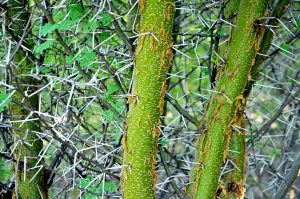
Acacia kirkii. Photo: Karl van Laeren. Source: Flora of Zimbabwe.
The Acacia kirkii is most interesting although I have never seen it in the wild. It has a thin peeling bark that resembles a Commiphora. It is common in the Chewore River in the Zambezi Valley where it forms solid stands in depressions. It is rare around Plumtree. This specimen has never fruited in the gardens. We must thank Tom Muller for another very entertaining walk. Tom seems to take delight in terrorizing us with this difficult genus.
Kim Damstra.
CHRISTMAS 1989
We had a family gathering at Nkwazi Cottage beside the Charara river at Lake Kariba. It was traditionally merry and ecologically delightful. Our temporary home was shaded by a fine young Baobab tree and a splendid Acacia which was A. robusta subspecies glavigera, it was tall, dense and graciously spreading. The foliage was bright green, its globose flowers were the palest yellow. Those of us who slept on the terrace awoke to find their mosquito nets bedecked with ‘mimosa’ flowers, these got into everything and came home with us and became an unintentional reminder of the trip. Once seen, Splendid Acacia should never be confused with A. gerrardii; but some of the latter have a denser crown, less curved pods which are more woody and fatter than usual for this species. Whilst at the ‘greeting’ cottage the Baobab shed a flower. It consisted of 5 white waxy petals joined to a hollow crown of stamens, this had separated from the slender beginnings of the Cream of Tartar fruit. We fitted the flower together again to see how it could be pollinated by bats and birds. Kim St. J. Damstra wrote about Malvales (the cotton Order) in Science News Sept/Oct. 1986. Baobab, snot apple and holly hock belong to this Order, Kim explains their structure and pollination mechanism. Bulbuls, weaver birds, trumpeter hornbills and marimba resonant coucals in the two beautiful trees ensured that we were awake to experience the predawn time. Close to us, a few hours later a male herd of elephant moved to the lake shore and went back upstream in the afternoon. From the boat we caught a glimpse of a Nyala tree (Xanthocercis zambesiaca) with pale coloured plum like fruits. At a fishing spot we happened to moor the boat to a branch which bore a Kariba sponge, new to some of us. On Christmas Day at dusk a crowd gathered at the Charara Marina to watch a lone hippo spectacular. No damage occurred but boats returning during the performance had to tie up elsewhere. Near the Angler’s Camp swimming pool there is a tall indigenous tree which, in December, looks like a Bouganvillea but is Terminalia prunioides bearing fruit in great profusion. Recently the name Terminalia chebula caught my eye in a shop in Manica Road. It was label on a little red barrel of medicine for indigestion. This remedy comes from India and thereabouts. Here in Zimbabwe the N’ganga uses root and bark preparations of Terminalia sericea for widely different ailments including abdominal pain. Christmas fare and New Year whoopee tests the constitution so it is timely to wish each other Good Health in the New Year.
Dicky Graves
SHONAS MEET BAIKIAEA
Quality, rather than quantity of trees and members was the order of the day when we took Maureen and Dick to the Kalahari sand area at Pasipas on Tuesday, 27th December. We started off at our usual stamping ground of acacias, and in a small area came across Acacia gerrardii (a hint of grey tip and seed pods shaped like a “G” was useful), A. fleckii, A. rehmanniana, A. karroo, A. erioloba, A. galpinii, A. nilotica and then we went on to met the hostess, Anne Visser, who accompanied us on the trip to the true Kalahari sand area. The
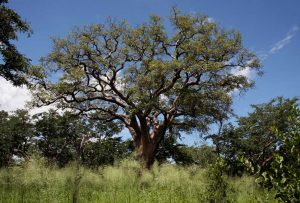
Ricinodendron rautanenii . Photo: Bart Wursten. Source: Flora of Zimbabwe.
Ricinodendron rautanenii. (Schinziophyton rautanenii) had leaves but no flowers or seeds, and then on one road it was pointed out that the teak, Baikiaea plurijuga encompassed the area on the left and none across the road! In the sodic soil area the Colophospermum mopane were changing colour, and we came across both the Commiphora schimperi (which we knew) and the Commiphora pyracanthoides (which we were shown) – and Dennis discovered a Ceropeaia nilotica (a member of the ASCLEPIADACEAE family) which made Norma’s day. Another find was the Acacia goetzii, large, and showing all the right features near a very large Ziziphus mucronata and Acacia nigrescens, and a truly magnificent Ficus thonningii. Ann whooped with joy and dashed out of the car to load up with sour plums, Ximenia caffra, to hand around, and while we agonised over the taste, we wondered why Dick was still smiling – until he proudly produced a nectarine! Although hot, it is still a satisfying and interesting area to explore, made even better, sitting on the verandah drinking ice cold orange juice, thank you Ann for the hospitality, and thank you Dick and Maureen for joining us in Bulawayo.
Ken Blake
CHRISTMAS IN THE MATOPOS : 1989
For me, Christmas has always been a time of enchantment – enchantment with the mystery of the Christmas story, enchantment with the mysterious comings and goings of St Nicholas and Santa Claus. Add to this a spell in one of the most enchanting parts of the country, and it nearly becomes too much for the mind! St Nicholas came on Christmas Eve in the shape of Ken and Betty Blake and Norma Hughes, who took us along the drive past Laing’s Graveyard to Lower Outspan and Efifi, unwrapping surprise after surprise along the way. Crossopteryx febrifuga with glinting crystals showing plainly on the bark’s inner surface, Turrea obtusifolia, flowering, Grewia villosa, flowering, Olea europa subs. africana also flowering – all this before lunch. We lunched under Cordia grandicalyx, groaning with large acorn like fruit in frilled cups, amid Turrea fisheri, Strychnos matopensis and Maytenus heterophylla sub. puberula (the Matobo subs with very small leaves and very fierce small spines) – the wonders never ceased. And then, to cap it all, Ken emerged from the bush with a sample of Ochna glauca, fruiting, and then led us off to a very large Zanthoxylam capense – St Nicholas final present. What a wonderful introduction to the Matopos!.
Friday 29th December. Ken and Betty took us to shumbashava Mkulu, Roy Stevens’ property on the north eastern edge of the Matobo area (the Matopos National Park is part of this area). The Bulawayo fundis had already identified 120 species here, but many more await discovery. We added a few to the list this day. The unarmed trees with very shiny leaves turned out to be a spineless Dovyalis zeyheri. The unknown tree with large purple fruit has been identified as Chionanthus battiscombii. Roy had found a fine Ochna holstii in fruit and Terminalia brachystemma was found on the level ground at the top of the property. The very small leaved fig that Roy had identified as Ficus cordata (was once Pretoriae and then Salicifolia) and which caused much thumbing through the books turned out to be precisely what Roy said it was. Our tortuous route from a very wild and attractive river bed led us through a narrow cleft in some large rocks which proved to be a tight squeeze for the non-weight watchers. There, cunningly concealed in a small cave, were several grain storage bins in pristine condition. To round off an exciting day in wonderful company we collected Teclea rogersii (or was it Vepris reflexa?), Erythrococca trichogyne, Olinia vanguerioides, Olax dissitiflora and Tarenna zimbabwensis.
Sunday 31st December. Accompanied by Geoff Archer, who, besides having a wide ranging knowledge of trees, is very clued up on the Black Eagle, we walked to Nanke Cave. The splendours of the views along the way, the striking paintings in the cave and on two small friezes en route, created an impression that will live with us forever. The trees? Well there was Ochna glauca, fruiting,
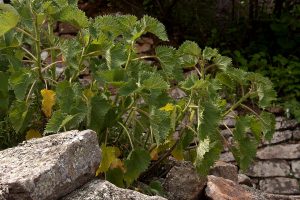
Obetia tenax. Photo: Bart Wursten. Source: Flora of Zimbabwe
Obetia tenax, hostile, Albizia tanganyicensis, writhing, Vitex isotjensis, flowering, Strychnos usambarensis, with fruit that has a narrow neck where it joins the stem, Entandrophragma caudatum scattering wooden bananas all over the place, Hexalobus monopetales var. monopetalus, fruiting, Erythroxylum emarginatum, also fruiting. We saw Calodendrum capense, flowering, Ptaeroxylum obliquum, heavy in fruit, and Heteropyxis dehniae growning with flowers. We saw – well, I could go on forever. The enchantment endures.
NYARUPINDA CATCHMENT : January/February 1990
The rainfall since the onset of rains until the end of 1989 has been 177mm or 7 inches.
Here is a list of trees and shrubs which were flowering on New Year’s Day 1990. these were identified en route within strolling distance of the house on the morning after the night before.This began casually as a ‘kajongwe’ recce, the first blooms were opening on both the erect and climbing forms of this one very variable species Gloriosa superba, our national flower. Acacia amythethophylla, A. gerrardii, A. nilotica, Allophyllus africanus, Azanza garckeana, Bauhinia petersiana, B. thonningii, Cussonia arborea, Dichrostachys cinerea, Diplorhynchus condylocarpon, Ficus thonningii, Flueggea virosa, Grewia herbacea, Grewia monticola, Hymenodictyon floribundum, Hoslundia opposite, Julbernardia globiflora, Lantana camara, Lantana angolensis, Maerua triphylla, Maytenus undata, Monotes engleri, Monotes glaber, Ochna macrocalyx, Ozoroa insignis, Pavetta schumanniana, Peltophorum africanum, Pleurostylia africana, Pouzolzia mixta, Psorospermum febrifugum, Pterocarpus rotundifolius subsp. polyanthus, Rhus longipes, Strychnos innocua (33 species).
Benedicta Graves Raffingora
JANUARY OUTING TO GALLOWAY ESTATE, NORTON
In my home village we have the local gossip column in which all social occasions are described in delightful terms. The mother of the bride always seems to trip along in pink taffeta and radiance is emitted from smiling faces. Galloway Estate would have provided a field day for such extravagance. From the emerald lawns, colourful hanging baskets, a sumptuous tea to the magnificent sunset that would have done some chocolate box proud. Descriptions become meaningless so with many thanks to our hostess, Lindy, let’s get on with the business of the day. The geology map shows that Galloway Estate is on the Mcilwaine greenstone (schist) belt. One ridge of banded ironstone snakes along parallel to the road and hold back Lake McIlwaine, another band forms a line of broken hills on the northern side. Lindy’s cottages nestle amongst the rocks on one of these hillsides. Each of these individual islands of vegetation is interesting. Amongst the rocks above McIlwaine wall there is Ficus abutilifolia and at Saffron Walden (not too far off) there is a colony of Nuxia congesta and a well established Kigelia africana. Galloway has a number of interesting trees but the most surprising of these is
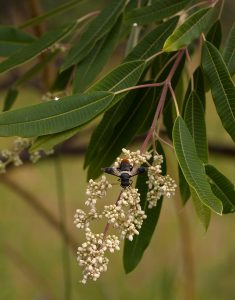
Ozoroa longipetiolata. Photo: Bart Wursten. Source: Flora of Zimbabwe.
Ozoroa longipetiolata. This seems out of place here as it is usually associated with the Great Dyke. The geology map shows an outcrop of Serpentine on the south west margin of this greenstone belt but not in the vicinity of Galloway. Strangely, none of the other species commonly associated with serpentine was particularly common. For example, there was no Acacia karroo, Combretum molle was present but not particularly common, and Bolusanthus speciosus (which is common around Selous) was also absent. Ozoroa longipetiolata is thus an interesting anomaly. The morning’s walk (we hardly moved out of the garden, was most interesting. I revised the taxonomy of compound leaves but forgot to tell everyone that the compound leaves with odd leaflets which I dealt with only includes those with ALTERNATE leaves. If the leaves themselves (not the leaflets) are opposite or occur in whorls of 3 or 4 then the tree belongs to the BIGNONACEAE (sausage tree family), OLEACEAE (Olive family), or it could be one exception in the RUTACEAE (citrus family). Of the specimens that we saw a number were particularly large. These included Pavetta gardeniifolia which is often only a shrub, Cassine matabelica and Clerodendrum myricoides, as well as fine specimens of Erythroxylum emarginatum. I suspect that these trees are naturally well developed although at present the increased water supply in the dry season may help to encourage them. The kopje has evidence of previous occupation which much refuge walling along the ridge. We were soon distracted by the fig trees and started pulling fig fruit apart, an exercise that kept us entertained for an extended period.
Kin Damstra.
MUTARE TREE NOTES
Everyone must have noticed the sausage tree, Kigelia africana in full fruit at present. The bat and bird pollinated unpleasant smelling velvety maroon flowers give rise to these very fibrous and inedible fruits. However, there is a recipe for this which starts with “take an axe”. The chopped fruit is boiled in water for several hours and the residue applied to skin lesions caused by the sun. It is very effective in their cure and in curing warts. The raw juice can also be applied. In the same family, with very similar leaves, we have occurring here, are Stereospermum kunthianum (very rare) and Markhamia obtusifolia with large maroon veined yellow flowers and which occurs very frequently. Incidentally, the Hymenocardia acida of which I wrote last time are in full leaf and heart shaped female fruit now. They form a very striking and beautiful stands.
Gail Henning
MUKUVISI WOODLAND NOTES
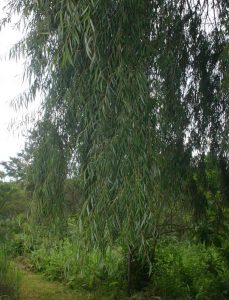
Salix babylonica. Photo: Bart Wursten. Source: Flora of Zimbabwe
Previously I have mentioned changes in plant succession following the start of our controlled fire programme which quickly brought an increase in species diversification and population numbers for less common plants. Recent years have seen a less systematic approach to fire management with the result that much of the public walking area is once again near to a fire interrupted climax. However, inside the game enclosure succession remains very active. I will talk about the Chiraura riverine strip. Above the Pan there is very little change in the overall grassland environment (here I ignore the changes in the species composition amongst grasses). The stand of Acacia rehmanniana just inside the north fence has largely gone through its lifespan to near senility and is being replaced by a mixed species woodland patch, which in isolation is subject to heavy browse and consequently no clear pattern is emerging. Below the Pan real interest begins, first with the regeneration of Ehretia amoena on a termitaria, delightful in flower, these are now mature plants and they date from first fire control in 1981. This dense stand provides important animal habitats. Under the dead gum trees early promise of a new riverine woodland from bird spread seed has not developed. Heavy browse is a contributory factor. Rhamnus prinoides made a good start as soon as we built the First Dam but I have not been able to find it for several years. Not browsed however, is Securinega virosa which is spreading nicely here. Before we move on I must mention the colony of Equisetum ramosissimun the common horsetail, trees they are not, but still worthy of notice lowly survivors though they are, they need recognition, obeisance even as almost the last of their kind. Moving downstream from the dam wall we enter the main area of recent regeneration where before 1982 was naught but degraded grassland and exotic timber, now we have pioneer growth of Acacia sieberiana and Fraxinus pennsylvanica over Euclea natalensis, Celtis africana, Dovyalis zeyheri. Full fire protection from 1982 was broken in July last by what I think was an unwise hot burn which interfered with succession and eliminated some interesting new fire tender growth. A word about Fraxinus, the white ash. Pre 1982 this plant was unknown along the Chiraura, it took advantage of fire control and spread quite amazingly. It does not seem to be hurting the indigenous plant life, rather the opposite. Its full role here would make an interesting study. The hot burn destroyed the reed beds encouraged and in fact nurtured since 1981, quite what the effect on the surrounding tree growth of the removal temporarily of the competition remains to be seen. This area is extremely interesting, I still name it the ‘second dam site’ from the impoundment which we planned here but never constructed. Just before the Chiraura leaves the game enclosure the mature groves of Salix babylonica commence. This plant and its ecological status here deserve a special paragraph all on its own, at some future time.
-George Hall.
STOP PRESS
Self catering accommodation for a limited number of members has been booked at Victoria Falls from 16th to 19th April.
Briefly, First come first served, self catering, own transport, about $17 per person per night. Phone Maureen Silva Jones on Harare 737711 or write to Box 2128 Harare, for booking. More in the next Tree Life.
FOOTNOTE The winter flowering Senna singueana which flowers from about March to September will often have what appears to be a spider’s web nest hanging from the ends of their branches. These are the nests made by the caterpillars of the moth Diapalpus congragarius. The moth lays her eggs on the Senna long before the new leaves emerge, the larvae or caterpillars hatch out and feed on the young leaves until, in time, when ready to pupate they weave this nest as a shelter in which to build their cocoons. Eventually the cycle is complete and the new moths emerge. They are 4 to 6 cm in wing span and light or golden yellow in colour. The same nest can be used more than once. To find this nest is a good identification of Senna singueana. The nests are sometimes ripped open by some predator.
SEED SAGA Tom Muller is delighted at the extent of the response that he is getting to his appeal for seeds. For those who are sending already, thanks a million. To those who have not, the advice is, if in doubt, gather it and send it. Tom will dispose of it if it is not much good. Come along! The trees are groaning with fruit.
DICK HICKS CHAIRMAN


